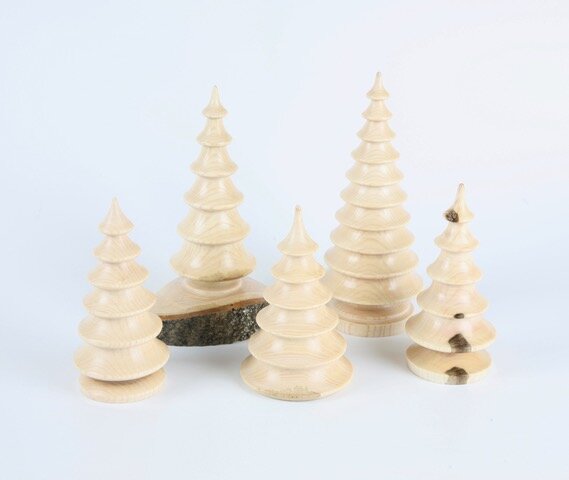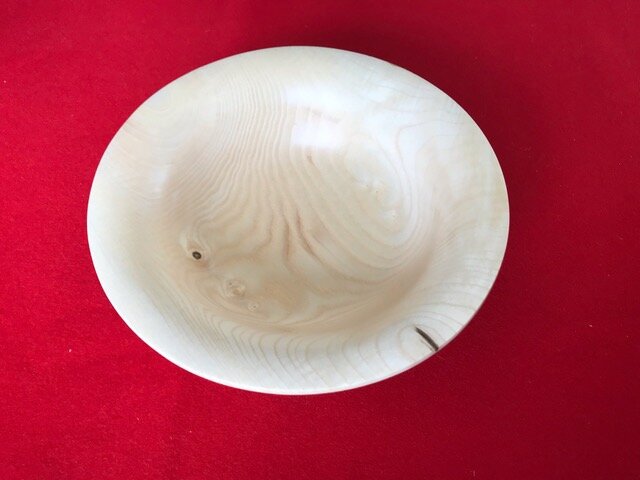One Ash: George Shapland
Welcome to our new fortnightly blog for the One Ash project. The project launched in 2020 with the aim of giving young people from four Andover schools a greater understanding of the role of trees in our lives. The project connects the school children with crafters, artists and other people who work with wood on a daily basis.
On 13th February 2020 the children, crafters, artists and wood-workers witnessed the felling of an ash tree on the Englefield Estate near Reading. The tree was then divided and distributed to the individual wood-workers and you can follow the journey of the wood and the many different forms it will take through the One Ash journal pages.
Here we catch-up with George Shapland, a Wiltshire-based artist and woodturner, to find out what he has been up to with his piece of ash and get an insight into his process.
George’s studio and tools
What have you been up to with your piece of Ash since the felling day - could you tell me a little about the process from a chunk-of-wood to a beautiful bowl please?
The piece of wood I picked up was part of the trunk and was between 25 and 30cm in diameter. I have halved it and with the intention of making two bowls and some little Christmas trees from one half. The Christmas trees worked well, but the pieces for the bowls had developed cracks. I was able to make a small bowl from one of the pieces, but the other was too far gone.
The process of a chunk (we call it a blank ;-)) to bowl can vary slightly depending on the size and type of wood, but in general terms, I halve the log down the centre and and with the flat side down, cut it roughly round on a band saw before mounting it in the lathe. Once on the lathe I can roughly shape the outside and create a tenon on the base which allows me to mount it in a chuck and then refine the outside and hollow out the inside. A light sanding and finish with a wax furniture polish completes the process.
I’m interested in your segmented designs - how do you approach this?
For any of the complex designs, I sketch an idea out and then draw up a full size drawing on graph paper which allows me to work out the size of each segment. I then cut all the pieces I need and then glue up a series of rings. These are then sanded on both sides and then glued up in a stack. The final phase is to mount on the lathe to refine the shape and finish.
What is the difference between working with green wood and seasoned wood?
Green wood is much easier to work with, but you have to be quick because as the wood dries, it moves and changes shape so is no longer round. It can also be very messy as there is a lot of water in green wood and as you spin the piece it flings the water out and it goes everywhere. The upside is that you can get some beautiful organic shapes as the bowl dries, and it is always a surprise. Seasoned wood is much more stable, but is often slower to cut because the wood is harder, but even that will move a little due changes in the humidity of the atmosphere.
What is your favourite wood?
What a hard question, it's a bit like asking which is your favourite child! That said I love the wide range of colours and grains found in exotic hardwoods (all from FSC approved sources) and use them a lot. However, if I had to pick one it would be home grown Boxwood because it is such a delight to work with and the finish is almost like marble.
How did you get started with your craft?
I first started at school, but with only one lathe to be shared by the class, we never got enough time on it. I bought my first lathe about 15 years ago and tried to make stuff from the firewood pile, but it was not a success and I lost heart and gave it up. It was a chance encounter in 2017 with an old friend and former colleague who put me in touch with Stuart Mortimer who is a Master Turner and internationally acclaimed artist in wood and I undertook a course with him and it has transformed my life. He has continued to encourage and mentor me ever since and supported me as I became a full time turner.
What are your essential tools?
A lathe, some chisels and a way of sharpening them is probably the minimum. Don’t be fooled by the rack of tools in the photo (at the top of the blog), there are probably only four that I use for 95% of the time, but I can’t resist the urge to add to my collection when something takes my fancy. Oh and a broom is a good idea, but as you can see, it is low on the list of my priorities.
Are you noticing a growing interest in wood craft revival at the moment?
I think that we are all becoming more aware of the environment and wood is a beautiful and renewable resource, as long as it is harvested sustainably.
How do you see the future for wood craft? What would you say to anyone wishing to get started?
I like to think it is relatively secure, but like any skill it takes time and practice to develop. The best way of getting started would be to have a taster session with a professional turner who will be able to help you gain the basic skills and allow you to try turning in a safe manner without getting dispirited like I did. For most of us, it is a passion that we love to share. The website for the Register of Professional Turners has a list of their members and allows you to see who is in your area. Lastly, it is something anyone can have a go at, my best student to date was a 15 year old girl who took to it like a duck to water.
If you would like to find out more about George’s work with the One Ash project follow his journal.
You can read about all the crafters, artists and wood-workers on the One Ash project page.
An exhibition of the One Ash project, including George’s work, is planned for 2022 and will form part of the 10-year celebration of all that Andover Trees United has achieved, including the completion of planting in Harmony Woods.










